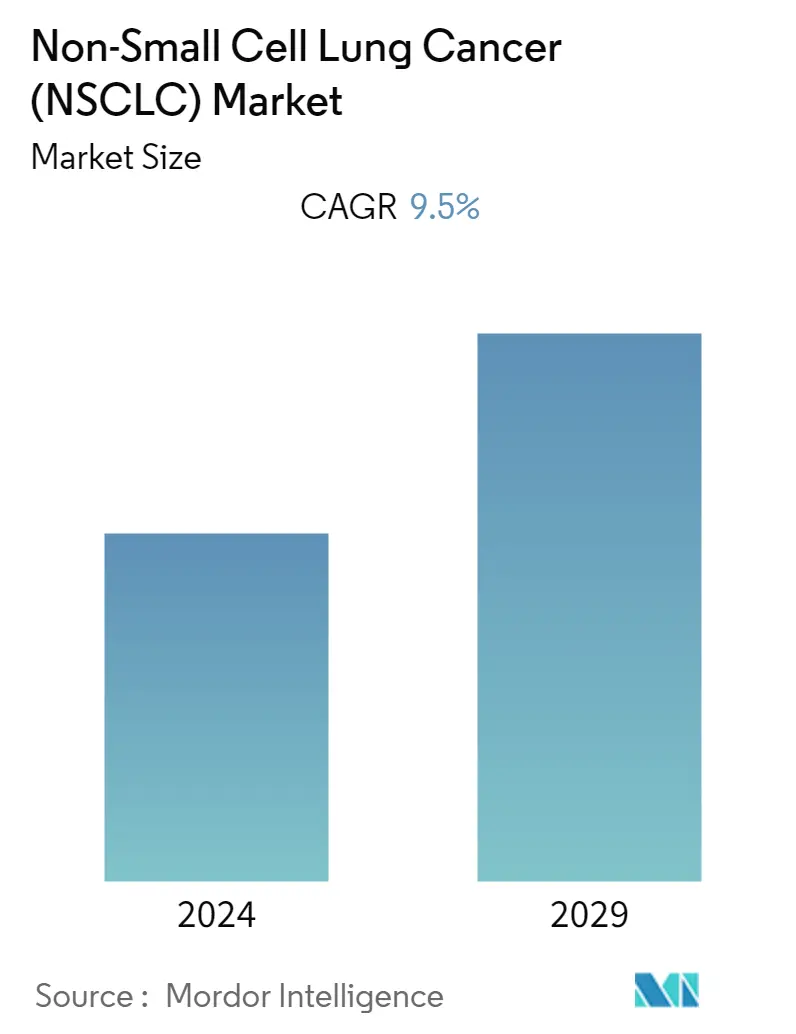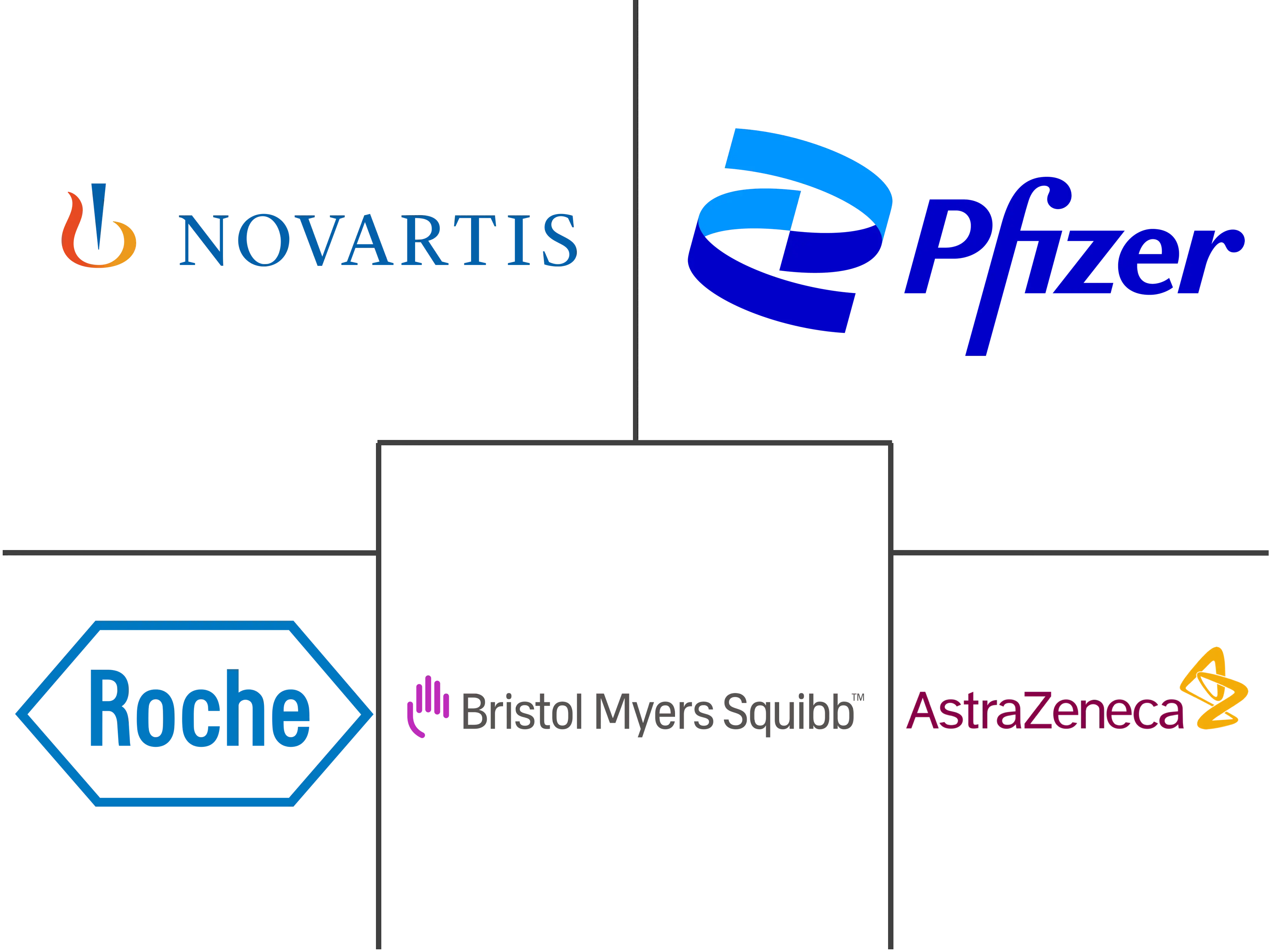Market Size of Non-Small Cell Lung Cancer (NSCLC) Industry

| Study Period | 2019 - 2029 |
| Base Year For Estimation | 2023 |
| Forecast Data Period | 2024 - 2029 |
| CAGR | 9.50 % |
| Fastest Growing Market | Asia-Pacific |
| Largest Market | North America |
Major Players
*Disclaimer: Major Players sorted in no particular order |
Non-Small Cell Lung Cancer (NSCLC) Market Analysis
The non-small cell lung cancer (NSCLC) market is expected to register a CAGR of 9.5% during the forecast period.
COVID-19 has significantly affected the growth of the non-small cell lung cancer market. For instance, as per clinicaltrials.gov, as of July 2021, more than 200 interventional studies were halted during the pandemic. This has slowed down the market growth during the pandemic. However, with the released restrictions and resumed services, the company has increased its focus on conducting clinical trials for the treatment of non-small cell lung cancer. For instance, in October 2022, Daiichi Sankyo, Inc. in partnership with AstraZeneca is conducting a Phase II clinical trial to evaluate the safety and efficacy of trastuzumab deruxtecan in HER2-mutated metastatic non-small cell lung cancer (NSCLC). Thus, with such activities, the studied market is expected to grow over the forecast period.
The growing number of patients suffering from non-small cell lung cancer and the increasing number of people with unhealthy habits such as smoking, tobacco and alcohol consumption, high dose of supplements, and sedentary lifestyle across the world are driving the market growth. For instance, according to the news published in December 2022, globally about 2.20 million new cases are among 11.4% of total thoracic tumor cases and this number is projected to double by 2025. Also, as per the data published by National Cancer Registry Programme (ICMR-NCRP), in December 2022, the number of lung cancer cases increased from 98,278 in 2020 to 1,03,371 in 2022, representing an increase of 5%. Thus, the high burden of lung cancer among the population has increased the demand for effective treatment options, which in turn is anticipated to fuel market growth.
Furthermore, the increasing company's focus on conducting R&D of effective drugs for the treatment of NSCLC and the increasing product approvals and various therapy designations are contributing to the market growth. For instance, in October 2022, GSK plc reported positive results from PERLA, the phase II trial of Jemperli (dostarlimab) plus chemotherapy in patients with metastatic non-squamous non-small cell lung cancer. Also, in June 2022, the European Commission approved Novartis's Tabrecta (capmatinib) as a monotherapy for the treatment of adults with advanced non-small cell lung cancer (NSCLC) who require systemic therapy following before treatment with immunotherapy and/or platinum-based chemotherapy. Similarly, in February 2022, the Medicines and Healthcare Products Regulatory Agency (MHRA) approved Genentech's Tecentriq to treat early-stage non-small cell lung cancer.
Moreover, the increasing investment by companies in developing effective therapies for treating patients with lung cancer is also expected to fuel market growth. For instance, in January 2023, DeuterOncology, a clinical-stage drug development company, closed EUR 5.65 million (USD 6.1 million) Series A financing round. This funding enables the company to initiate the phase I clinical study for its lead product DO-2, an improved MET kinase inhibitor that is being developed as a potential best-in-class targeted therapy for lung cancer. MET inhibitors have recently been approved for patients with Non-Small Cell Lung Cancer (NSCLC) harbouring the MET exon 14 skipping mutant.
Therefore, owing to the factors such as the high burden of non-small cell lung cancer, growing R&D activities, and product approvals, the studied market is anticipated to grow over the forecast period. However, the high cost of therapy or drugs and low diagnosis rate in developing countries is likely to impede the growth of non-small cell lung cancer over the forecast period.
Non-Small Cell Lung Cancer (NSCLC) Industry Segmentation
As per the scope of the report, non-small cell lung cancer is a type of epithelial lung cancer, excluding small-cell lung carcinoma. The Non-Small Cell Lung Cancer (NSCLC) Market is Segmented by Cancer Type (Squamous Cell Carcinoma, Adenocarcinoma, Large-cell Carcinoma), Treatment (Chemotherapy, Targeted Therapy, Immunotherapy, Other Treatment Types), and Geography (North America, Europe, Asia-Pacific, Middle East and Africa, and South America). The market report also covers the estimated market sizes and trends for 17 different countries across major regions, globally. The report offers the value (in USD million) for the above segments.
| By Cancer Type | |
| Squamous Cell Carcinoma | |
| Adenocarcinoma | |
| Large-cell Carcinoma |
| By Treatment | |
| Chemotherapy | |
| Targeted Therapy | |
| Immunotherapy | |
| Other Treatment Therapy |
| Geography | ||||||||
| ||||||||
| ||||||||
| ||||||||
| ||||||||
|
Non-Small Cell Lung Cancer (NSCLC) Market Size Summary
The non-small cell lung cancer (NSCLC) market is poised for significant growth, driven by an increasing incidence of the disease and a surge in research and development activities aimed at developing effective treatment options. The market's expansion is supported by the growing prevalence of risk factors such as smoking, tobacco use, and sedentary lifestyles, which contribute to the rising number of NSCLC cases globally. The market has faced challenges due to the COVID-19 pandemic, which disrupted clinical trials and slowed progress. However, with the resumption of services and a renewed focus on clinical research, companies are actively conducting trials and seeking regulatory approvals for new therapies. This proactive approach is expected to bolster market growth over the forecast period.
The market is characterized by a competitive landscape with major players investing heavily in the development of targeted therapies, which are gaining traction due to their effectiveness in treating advanced lung cancers. These therapies, which include drugs like Erlotinib, Gefitinib, and Osimertinib, offer targeted action on mutated genes, minimizing adverse effects on healthy cells. The increasing approval of targeted therapies and their adoption in various regions are anticipated to drive market growth. North America, in particular, is expected to witness substantial growth due to the high incidence of NSCLC and the presence of key industry players. The market's growth is further supported by strategic collaborations, partnerships, and product launches by leading companies, ensuring a dynamic and competitive market environment.
Non-Small Cell Lung Cancer (NSCLC) Market Size - Table of Contents
-
1. MARKET DYNAMICS
-
1.1 Market Overview
-
1.2 Market Drivers
-
1.2.1 Increasing Investment for the Development of New Therapy
-
1.2.2 Increasing Prevalence of NSCLC
-
-
1.3 Market Restraints
-
1.3.1 High Cost of Therapy/Drugs and Low Diagnosis Rate in Developing Countries
-
-
1.4 Porter's Five Forces Analysis
-
1.4.1 Threat of New Entrants
-
1.4.2 Bargaining Power of Buyers/Consumers
-
1.4.3 Bargaining Power of Suppliers
-
1.4.4 Threat of Substitute Products
-
1.4.5 Intensity of Competitive Rivalry
-
-
-
2. MARKET SEGMENTATION (Market Size by Value - USD million)
-
2.1 By Cancer Type
-
2.1.1 Squamous Cell Carcinoma
-
2.1.2 Adenocarcinoma
-
2.1.3 Large-cell Carcinoma
-
-
2.2 By Treatment
-
2.2.1 Chemotherapy
-
2.2.2 Targeted Therapy
-
2.2.3 Immunotherapy
-
2.2.4 Other Treatment Therapy
-
-
2.3 Geography
-
2.3.1 North America
-
2.3.1.1 United States
-
2.3.1.2 Canada
-
2.3.1.3 Mexico
-
-
2.3.2 Europe
-
2.3.2.1 Germany
-
2.3.2.2 United Kingdom
-
2.3.2.3 France
-
2.3.2.4 Italy
-
2.3.2.5 Spain
-
2.3.2.6 Rest of Europe
-
-
2.3.3 Asia-Pacific
-
2.3.3.1 China
-
2.3.3.2 Japan
-
2.3.3.3 India
-
2.3.3.4 Australia
-
2.3.3.5 South Korea
-
2.3.3.6 Rest of Asia-Pacific
-
-
2.3.4 Middle East and Africa
-
2.3.4.1 GCC
-
2.3.4.2 South Africa
-
2.3.4.3 Rest of Middle East and Africa
-
-
2.3.5 South America
-
2.3.5.1 Brazil
-
2.3.5.2 Argentina
-
2.3.5.3 Rest of South America
-
-
-
Non-Small Cell Lung Cancer (NSCLC) Market Size FAQs
What is the current Global Non-Small Cell Lung Cancer (NSCLC) Market size?
The Global Non-Small Cell Lung Cancer (NSCLC) Market is projected to register a CAGR of 9.5% during the forecast period (2024-2029)
Who are the key players in Global Non-Small Cell Lung Cancer (NSCLC) Market?
F. Hoffmann-La Roche Ltd. , Bristol-Myers Squibb Company, Pfizer Inc. , AstraZeneca and Novartis AG are the major companies operating in the Global Non-Small Cell Lung Cancer (NSCLC) Market.

